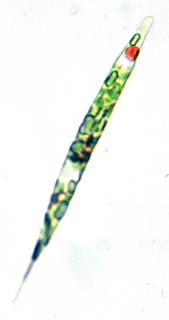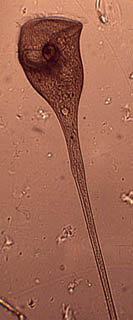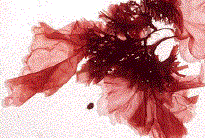BIOL 1400 -- Lecture Outline 7
�
"Freedom begins between the ears." --Edward Abbey
I. Kingdom Fungi -- Recommended supplementary Web site:
Introduction to the
Fungi
- Structure
- Cell walls made of a carbohydrate called chitin (unlike plant cell walls,
which use a different material, cellulose).
- The basic fungal body form is the hypha, a long, branching filament of cells
arranged end-to-end.
- Collectively the hyphae make up a mass called a mycelium. This often
looks "cottony" or fuzzy" to the naked eye (on spoiled food, rotten wood, etc.).
- Some fungi have hyphae that are partitioned into separate cells by septa --
but others have gaps in the septa, or don't have septa at all. In this case each hypha
may act like a single cell with many nuclei.
- Some fungi do not form hyphae. Instead, they start out as single cells
(usually oval or round) that bud off and form small clusters. These are called
yeasts (such as baker's yeast and brewer's yeast, which never form hyphae).
- Other fungi switch back and forth between hyphal and yeast stages. Example:
a fungus called Candida, which causes "thrush," an infection of the mouth
and throat that usually strikes babies.
- Reproduction:
- All fungi can reproduce asexually, by budding, branching, or forming spores
(single cells that break away and disperse to new habitats).
- Many (but not all) may also reproduce sexually.
- Two hyphae of different "mating types" (similar to genders, but fungal
mating types don't look outwardly different from each other) may fuse to
form a new type of hypha (with two nuclei per cell!)
- The new hypha "buds" to produce dustlike microscopic spores.
- The spores drop off, and, if conditions are right, "sprout" and grow into new hyphae, and the cycle goes on.
- The sexual hypha may sometimes grow, branch, and form a large mycelium. . .
- . . . . and in some cases, grow into a relatively large structure called, technically,
a sporocarp (examples: mushrooms, puffballs, bracket fungi, jelly fungi).
- Classification: Fungi are classified depending on how the sporocarp produces
sexual spores:
- Zygomycetes: Spores produced in clusters. (Example: Black bread mold)
- Ascomycetes: Spores produced in saclike organs. (Example: Yeasts,
morels, puffballs)
- Basidiomycetes: Spores produced at the tips of small clublike structures.
(Examples: Mushrooms, truffles, bracket fungi, jelly fungi)
- Imperfect fungi: No sexual reproduction at all; no sporocarps. (Example:
Athlete's foot and ringworm fungi, green mold)
- Famous fungi
- Parasitic fungi on humans include athlete's foot, ringworm, thrush, etc.
- Parasitic fungi on plants include rusts, smuts, blights, Dutch elm disease,
ergots, cankers, etc. -- costing the U.S. agricultural industry many millions of
dollars each year.
- When there's no oxygen present, yeasts survive by a process called
fermentation. The result of fermentation, in this case, is the breakdown
of sugars into two waste products: carbon dioxide gas and ethyl alcohol.
- Fungi are used as food (edible mushrooms) and in foods (the color and flavor
of blue cheese is caused by a fungus growing in the cheese).
- Fungi produce many useful drugs, including many antibiotics that
kill harmful bacteria (e.g. penicillin, produced by the blue mold Penicillus).
- This is as good a place as any to introduce a key concept: symbiosis --
a close ecological association between organisms of two (or occasionally more) dissimilar species.
- Symbiosis is very widely seen throughout the living world -- it's NOT
restricted to fungi at all, but this is a fairly convenient place to discuss it.
- There are several types of symbiosis, but I'll mention two here:
- Parasitism: A symbiosis in which one partner benefits and the
other is harmed. Examples: Fungi that grow on other organisms and cause disease.
- Commensalism: A symbiosis in which one partner benefits and the
other is neither helped nor harmed. Example: Bacteria on human skin.
- Mutualism: A symbiosis in which both partners benefit. Examples:
- Fungi that surround and sometimes penetrate into plant roots. They take
nutrients (such as sugars) from the host plant, and help the plant absorb certain
other nutrients (such as phosphorus) from the soil. About 90% of plant species
must have these mutualistic fungi to thrive. (The fungi are called mycorrhizae,
by the way. . . .
- A lichen is a mutualistic symbiosis between a fungus and a
single-celled green alga (or sometimes a photosynthetic bacterium). In a lichen
body (or thallus), millions of algal cells may live wrapped up in fungal
hyphae. The fungus gets food from the algae, and the algae get protection and
certain minerals from the fungus. (See
this Web site).
II. The Kingdom Protista -- Recommended supplementary Web sites:
Eukaryote Systematics;
Protist Image Data
- The Kingdom Protista is defined as "all eukaryotes that aren't animals, plants,
or fungi". . .
- A better definition would be to say that the Protista are eukaryotes that lack
extensive cellular differentiation and complex development.
- Many protists are single-celled, like Stentor and Euglena shown
below. . .


Euglena (a single-celled photosynthetic protist) and
Stentor (a single-celled heterotrophic protist)
- But many protists are multicellular.
- Seaweeds, for instance, are multicelled protists -- not plants!

Porphyra (a red seaweed)
- Volvox, which you saw briefly in the slide show, is yet another
multicelled protist.
- Many biologists split the Protista up into many kingdoms. (I wish we had time
to explore why! But for now,
here's a look
at some of the amazing diversity you find among protists.
- A few basic types of protists include:
- Ciliates, most of which swim by means of many short hairlike organelles called
cilia
- Flagellates, which generally swim using one or a few longer orgenalles,
flagella
- Amoebae, which have no defined shape and flow from place to place
- Protists that are harmful to humans include the organisms that cause malaria,
African sleeping sickness, amoebic dysentery, and "hiker's diarrhea" (Giardia).
Here's a look at some protists
that cause disease.
- A few others cause plant diseases: the most famous example is the potato
blight (the one that struck Ireland in the 1840s, causing famine).
- But most are quite harmless, and some are quite beneficial.
- Seaweeds are a food source in many areas (e.g. Japan). Carrageenan
is a seaweed product added to foods (e.g. cheap ice cream) to give them a
smooth texture.
- Chalk is a rock made up of countless billions of protist skeletons. So is
"diatomaceous earth," used as an abrasive and filtering agent.
- Animals such as cows and termites not only have countless bacteria
in their intestines, but have many protists as well, and these assist in digestion.
- Finally, in many habitats, protists are important food for other organisms.
Go to Previous Notes |
Return to Lecture Schedule |
Return to Syllabus |
Contact the Prof |
Go to Next Notes


